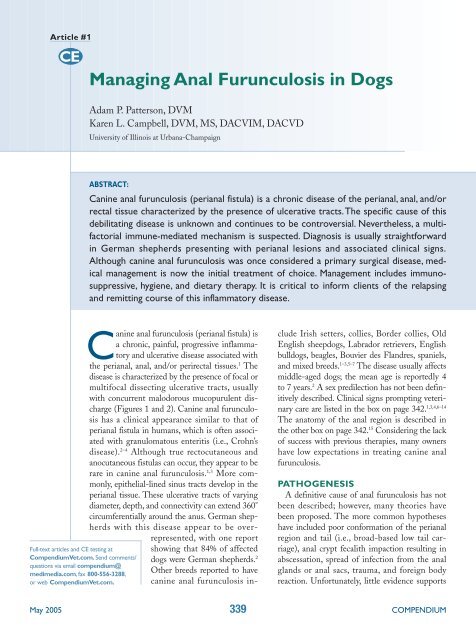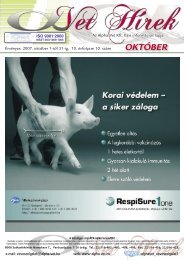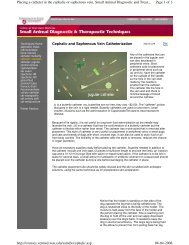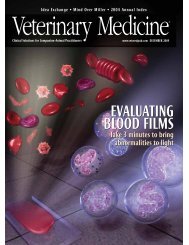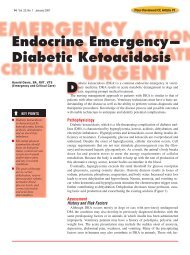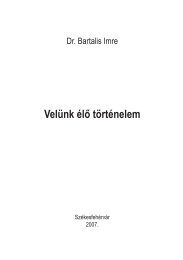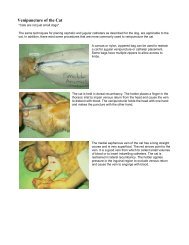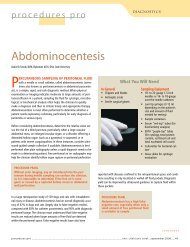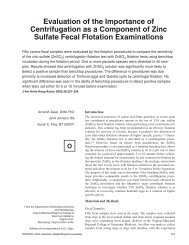Managing Anal Furunculosis in Dogs - Hungarovet
Managing Anal Furunculosis in Dogs - Hungarovet
Managing Anal Furunculosis in Dogs - Hungarovet
Create successful ePaper yourself
Turn your PDF publications into a flip-book with our unique Google optimized e-Paper software.
Article #1<br />
CE<br />
<strong>Manag<strong>in</strong>g</strong> <strong>Anal</strong> <strong>Furunculosis</strong> <strong>in</strong> <strong>Dogs</strong><br />
Adam P. Patterson, DVM<br />
Karen L. Campbell, DVM, MS, DACVIM, DACVD<br />
University of Ill<strong>in</strong>ois at Urbana-Champaign<br />
ABSTRACT:<br />
Can<strong>in</strong>e anal furunculosis (perianal fistula) is a chronic disease of the perianal, anal, and/or<br />
rectal tissue characterized by the presence of ulcerative tracts.The specific cause of this<br />
debilitat<strong>in</strong>g disease is unknown and cont<strong>in</strong>ues to be controversial. Nevertheless, a multifactorial<br />
immune-mediated mechanism is suspected. Diagnosis is usually straightforward<br />
<strong>in</strong> German shepherds present<strong>in</strong>g with perianal lesions and associated cl<strong>in</strong>ical signs.<br />
Although can<strong>in</strong>e anal furunculosis was once considered a primary surgical disease, medical<br />
management is now the <strong>in</strong>itial treatment of choice. Management <strong>in</strong>cludes immunosuppressive,<br />
hygiene, and dietary therapy. It is critical to <strong>in</strong>form clients of the relaps<strong>in</strong>g<br />
and remitt<strong>in</strong>g course of this <strong>in</strong>flammatory disease.<br />
Full-text articles and CE test<strong>in</strong>g at<br />
CompendiumVet.com. Send comments/<br />
questions via email compendium@<br />
medimedia.com, fax 800-556-3288,<br />
or web CompendiumVet.com.<br />
Can<strong>in</strong>e anal furunculosis (perianal fistula) is<br />
a chronic, pa<strong>in</strong>ful, progressive <strong>in</strong>flammatory<br />
and ulcerative disease associated with<br />
the perianal, anal, and/or perirectal tissues. 1 The<br />
disease is characterized by the presence of focal or<br />
multifocal dissect<strong>in</strong>g ulcerative tracts, usually<br />
with concurrent malodorous mucopurulent discharge<br />
(Figures 1 and 2). Can<strong>in</strong>e anal furunculosis<br />
has a cl<strong>in</strong>ical appearance similar to that of<br />
perianal fistula <strong>in</strong> humans, which is often associated<br />
with granulomatous enteritis (i.e., Crohn’s<br />
disease). 2–4 Although true rectocutaneous and<br />
anocutaneous fistulas can occur, they appear to be<br />
rare <strong>in</strong> can<strong>in</strong>e anal furunculosis. 1,3 More commonly,<br />
epithelial-l<strong>in</strong>ed s<strong>in</strong>us tracts develop <strong>in</strong> the<br />
perianal tissue. These ulcerative tracts of vary<strong>in</strong>g<br />
diameter, depth, and connectivity can extend 360°<br />
circumferentially around the anus. German shepherds<br />
with this disease appear to be overrepresented,<br />
with one report<br />
show<strong>in</strong>g that 84% of affected<br />
dogs were German shepherds. 2<br />
Other breeds reported to have<br />
can<strong>in</strong>e anal furunculosis <strong>in</strong>-<br />
clude Irish setters, collies, Border collies, Old<br />
English sheepdogs, Labrador retrievers, English<br />
bulldogs, beagles, Bouvier des Flandres, spaniels,<br />
and mixed breeds. 1–3,5–7 The disease usually affects<br />
middle-aged dogs; the mean age is reportedly 4<br />
to 7 years. 2 A sex predilection has not been def<strong>in</strong>itively<br />
described. Cl<strong>in</strong>ical signs prompt<strong>in</strong>g veter<strong>in</strong>ary<br />
care are listed <strong>in</strong> the box on page 342. 1,3,4,6–14<br />
The anatomy of the anal region is described <strong>in</strong><br />
the other box on page 342. 15 Consider<strong>in</strong>g the lack<br />
of success with previous therapies, many owners<br />
have low expectations <strong>in</strong> treat<strong>in</strong>g can<strong>in</strong>e anal<br />
furunculosis.<br />
PATHOGENESIS<br />
A def<strong>in</strong>itive cause of anal furunculosis has not<br />
been described; however, many theories have<br />
been proposed. The more common hypotheses<br />
have <strong>in</strong>cluded poor conformation of the perianal<br />
region and tail (i.e., broad-based low tail carriage),<br />
anal crypt fecalith impaction result<strong>in</strong>g <strong>in</strong><br />
abscessation, spread of <strong>in</strong>fection from the anal<br />
glands or anal sacs, trauma, and foreign body<br />
reaction. Unfortunately, little evidence supports<br />
May 2005 339 COMPENDIUM
340 CE<br />
<strong>Manag<strong>in</strong>g</strong> <strong>Anal</strong> <strong>Furunculosis</strong> <strong>in</strong> <strong>Dogs</strong><br />
any of these hypotheses. The current theory <strong>in</strong>volves a<br />
multifactorial immune-mediated disease process. An<br />
immune-mediated process is suspected because both<br />
can<strong>in</strong>e anal furunculosis and Crohn’s disease respond to<br />
down-regulat<strong>in</strong>g the immune response. 3,4,6,8,10–13,16,17 Accumulat<strong>in</strong>g<br />
evidence shows that<br />
Crohn’s disease is the result<br />
of an unbalanced host immune<br />
response to <strong>in</strong>test<strong>in</strong>al<br />
triggers <strong>in</strong> genetically susceptible<br />
humans. 17–19 Because<br />
German shepherds with<br />
can<strong>in</strong>e anal furunculosis also<br />
have cl<strong>in</strong>ical and histologic<br />
evidence of colitis (i.e.,<br />
<strong>in</strong>flammatory bowel disease<br />
[IBD]), perhaps enteral triggers<br />
(i.e., dietary antigens,<br />
bacterial antigens, superantigens)<br />
are <strong>in</strong>itiators of can<strong>in</strong>e<br />
anal furunculosis as well. 11<br />
This is an <strong>in</strong>terest<strong>in</strong>g speculation<br />
because the German<br />
Perianal<br />
fistulous<br />
tract<br />
Perianal<br />
s<strong>in</strong>us<br />
tracts<br />
Figure 1. Circumferential perianal s<strong>in</strong>us tracts and<br />
fistula <strong>in</strong> a dog. (Illustration by Mr. Kerry Helms)<br />
Internal anal sph<strong>in</strong>cter<br />
External anal sph<strong>in</strong>cter<br />
<strong>Anal</strong> sac<br />
Open<strong>in</strong>g of<br />
anal sac duct<br />
shepherd, the breed most often reported to have can<strong>in</strong>e<br />
anal furunculosis, also commonly has IBD. 20 Maybe the<br />
genetic makeup of some German shepherds produces<br />
heightened pro<strong>in</strong>flammatory immune responses, result<strong>in</strong>g<br />
<strong>in</strong> immune-mediated diseases. However, one study was<br />
unable to identify at least a simple immunologic defect as<br />
an underly<strong>in</strong>g factor <strong>in</strong> the predisposition of German<br />
shepherds to can<strong>in</strong>e anal furunculosis. 21 Another proposed<br />
<strong>in</strong>itiat<strong>in</strong>g factor of can<strong>in</strong>e anal furunculosis is staphylococcal<br />
folliculitis. 21<br />
Based on histologic evaluation, early can<strong>in</strong>e anal<br />
furunculosis lesions show an <strong>in</strong>flammatory reaction associated<br />
with epidermal appendages without concomitant<br />
epidermal ulceration. 5 As the <strong>in</strong>flammatory reaction<br />
<strong>in</strong>tensifies, folliculitis/furunculosis and nonarboriz<strong>in</strong>g<br />
s<strong>in</strong>us tracts develop <strong>in</strong> the perianal dermis. Perifollicular,<br />
superficial epidermal ulceration and arboriz<strong>in</strong>g dissect<strong>in</strong>g<br />
cellulitis soon follow throughout the perianal tissue. 5 The<br />
s<strong>in</strong>us tracts are typically l<strong>in</strong>ed by squamous epithelium<br />
and are <strong>in</strong>filtrated with a mixture of lymphocytes, plasma<br />
cells, macrophages, neutrophils, and eos<strong>in</strong>ophils. As perianal<br />
lesions progress, peripheral lymphoid nodules (predom<strong>in</strong>antly<br />
T lymphocytes) develop, along with<br />
extensive granulat<strong>in</strong>g fibrosis. 2,5,21 Interest<strong>in</strong>gly, it appears<br />
that anal sac disease usually occurs as a result of expand<strong>in</strong>g<br />
<strong>in</strong>flammation. 1,2<br />
PHYSICAL EXAMINATION<br />
Exam<strong>in</strong>ation of the perianal area of patients with anal<br />
furunculosis typically requires sedation or general anesthesia<br />
because of severe pa<strong>in</strong>. Clipp<strong>in</strong>g the perianal<br />
Perianal s<strong>in</strong>us tracts<br />
Rectum<br />
Anorectal l<strong>in</strong>e<br />
Columnar zone<br />
Intermediate zone<br />
Cutaneous zone<br />
Figure 2. Rectum and anal canal anatomy (opened along the middorsal l<strong>in</strong>e) depict<strong>in</strong>g<br />
s<strong>in</strong>us tract lesions. (Illustration by Mr. Kerry Helms)<br />
COMPENDIUM May 2005
342 CE<br />
<strong>Manag<strong>in</strong>g</strong> <strong>Anal</strong> <strong>Furunculosis</strong> <strong>in</strong> <strong>Dogs</strong><br />
Cl<strong>in</strong>ical Signs of Can<strong>in</strong>e <strong>Anal</strong><br />
<strong>Furunculosis</strong> 1,3,4,6–14<br />
• Tenesmus<br />
• Dyschezia<br />
• Hematochezia<br />
• Constipation or obstipation<br />
• Diarrhea<br />
• Ribbon-like stool<br />
• Increased frequency of defecation<br />
• Perianal purulent discharge and/or bleed<strong>in</strong>g<br />
• Perianal lick<strong>in</strong>g<br />
• Self-mutilation<br />
• Perianal pa<strong>in</strong><br />
• Scoot<strong>in</strong>g<br />
• Offensive odor<br />
• Low tail carriage<br />
• Weight loss<br />
region might be necessary to fully assess the severity of<br />
disease. Lesions may vary from superficial p<strong>in</strong>po<strong>in</strong>t<br />
tracts to large ulcerated areas (Figure 3). Several of these<br />
tracts may often be <strong>in</strong>terconnected. Tracts may tunnel<br />
deep with<strong>in</strong> the surround<strong>in</strong>g tissue and occasionally<br />
communicate with the rectum, anus, and/or anal sacs.<br />
The tracts should be probed with a sterile, blunt <strong>in</strong>strument<br />
to determ<strong>in</strong>e their extent and <strong>in</strong>volvement with<br />
regional structures. The external anal sph<strong>in</strong>cter, anal<br />
sacs, and rectal mucosa should be assessed. Thicken<strong>in</strong>g<br />
(i.e., fibrosis) of the anus and rectum can be palpated<br />
dur<strong>in</strong>g the rectal exam<strong>in</strong>ation. It is important to determ<strong>in</strong>e<br />
whether there is evidence of anorectal stenosis<br />
and/or per<strong>in</strong>eal hernia, which would affect the prognosis.<br />
The anal sacs may be normal, impacted, or ruptured.<br />
In addition, the anal sacs may be <strong>in</strong>corporated with<strong>in</strong><br />
surround<strong>in</strong>g tissue fibrosis. Cannulation of the anal sac<br />
ducts determ<strong>in</strong>es whether they are occluded. Flush<strong>in</strong>g<br />
the anal sacs with sterile sal<strong>in</strong>e may reveal a previously<br />
unobserved fistulat<strong>in</strong>g tract. The primary diagnostic differentials<br />
<strong>in</strong>clude anal sac abscessation, perianal adenoma,<br />
anal sac adenocarc<strong>in</strong>oma, anal squamous cell<br />
carc<strong>in</strong>oma, rectal neoplasia, atypical bacterial <strong>in</strong>fection,<br />
mycosis, and oomycosis (i.e., pythiosis, lagenidiosis).<br />
DIAGNOSTIC EVALUATION<br />
The diagnosis of can<strong>in</strong>e anal furunculosis is based on<br />
history, physical exam<strong>in</strong>ation f<strong>in</strong>d<strong>in</strong>gs, and rul<strong>in</strong>g out<br />
other primary diagnostic differentials. Obta<strong>in</strong><strong>in</strong>g a m<strong>in</strong>imum<br />
database is always at the discretion of the cl<strong>in</strong>ician,<br />
but a complete blood count, serum biochemical<br />
Anatomy of the <strong>Anal</strong> Region<br />
<strong>Anal</strong> canal—Small portion of the alimentary canal that<br />
extends from the term<strong>in</strong>al part of the rectum to the<br />
anus. It is roughly 1 cm long. The <strong>in</strong>ternal anal<br />
sph<strong>in</strong>cter (<strong>in</strong>voluntary smooth muscle) and the<br />
external anal sph<strong>in</strong>cter (voluntary striated muscle) are<br />
positioned between the rectum and anus. Sensory and<br />
motor functions are supplied by the pudendal nerve<br />
and its branches. 15<br />
<strong>Anal</strong> sacs—Spherical reservoir sacs that are<br />
<strong>in</strong>vag<strong>in</strong>ations between the <strong>in</strong>ternal and external anal<br />
sph<strong>in</strong>cter muscles. One sac is on each side of the anal<br />
canal. Their ducts open onto the cutaneous zone. The<br />
sac walls conta<strong>in</strong> coiled apocr<strong>in</strong>e sweat glands with<br />
scattered sebaceous glands. 15<br />
Anus—Term<strong>in</strong>al open<strong>in</strong>g of the alimentary canal. The<br />
anal tissue is divided (from cranial to caudal) <strong>in</strong>to the<br />
columnar, <strong>in</strong>termediate, and cutaneous zones. 15<br />
Columnar zone—Conta<strong>in</strong>s longitud<strong>in</strong>al ridges (i.e.,<br />
anal columns) with shallow valleys (i.e., anal s<strong>in</strong>uses)<br />
that term<strong>in</strong>ate caudally as bl<strong>in</strong>d pockets (i.e., anal<br />
crypts) at the anocutaneous l<strong>in</strong>e (i.e., <strong>in</strong>termediate<br />
zone), result<strong>in</strong>g <strong>in</strong> a scalloped fold. It conta<strong>in</strong>s<br />
modified tubuloalveolar sweat glands.<br />
Cutaneous zone—Conta<strong>in</strong>s an <strong>in</strong>ner hairless portion<br />
and an outer relatively hairless portion that are part of<br />
the mucocutaneous junction. The anal sac ducts open<br />
onto the <strong>in</strong>ner portion of this zone at the lateral angles<br />
of the anus. This zone conta<strong>in</strong>s circumanal (hepatoid),<br />
sebaceous, and apocr<strong>in</strong>e sweat glands.<br />
Intermediate zone—Also known as the anocutaneous<br />
l<strong>in</strong>e, it spans the perimeter of the anal canal. It is less<br />
than 1 mm wide. This zone also conta<strong>in</strong>s modified<br />
tubuloalveolar sweat glands.<br />
Rectum—Caudal portion of the large <strong>in</strong>test<strong>in</strong>es that lies<br />
with<strong>in</strong> the pelvic canal. The boundary between the<br />
rectum and anal canal is known as the anorectal l<strong>in</strong>e,<br />
which is marked by transition from columnar to<br />
stratified squamous epithelium 15 (Figure 2).<br />
profile, and ur<strong>in</strong>alysis are useful before anesthesia and to<br />
rule out concurrent diseases. Superficial cytology is a<br />
standard tool for evaluat<strong>in</strong>g the cutaneous and s<strong>in</strong>us<br />
tract microenvironment. It <strong>in</strong>variably reveals pyogranulomatous<br />
<strong>in</strong>flammation with a mixed bacterial population.<br />
F<strong>in</strong>e-needle aspiration of an enlarged anal sac is<br />
warranted to rule out abscessation or neoplasia. S<strong>in</strong>us<br />
tracts should be cultured with a sterile swab or tissue<br />
biopsy for bacterial culture and susceptibility test<strong>in</strong>g<br />
because controll<strong>in</strong>g secondary <strong>in</strong>fection with antibiotics<br />
may take weeks to months. Tissue biopsy for histopathology<br />
can be used to verify the tentative diagnosis<br />
COMPENDIUM May 2005
<strong>Manag<strong>in</strong>g</strong> <strong>Anal</strong> <strong>Furunculosis</strong> <strong>in</strong> <strong>Dogs</strong> CE 343<br />
of can<strong>in</strong>e anal furunculosis and to<br />
rule out neoplasia. Biopsy sites are<br />
usually allowed to heal by second<br />
<strong>in</strong>tention. A restrictive diet trial<br />
should be implemented to rule out<br />
concurrent adverse food reactions.<br />
Other diagnostics that may prove<br />
helpful <strong>in</strong>clude fecal flotation cytology,<br />
rectal scrap<strong>in</strong>g cytology, fungal<br />
culture, colonoscopy with biopsy,<br />
and pelvic radiography.<br />
Figure 3. Cl<strong>in</strong>ical presentation of can<strong>in</strong>e anal furunculosis.<br />
MANAGEMENT<br />
Primary surgical treatment of<br />
can<strong>in</strong>e anal furunculosis was previously<br />
advocated. Surgical procedures<br />
focus on either destroy<strong>in</strong>g the<br />
epithelial l<strong>in</strong><strong>in</strong>g of s<strong>in</strong>us tracts or<br />
total en bloc tract excision to<br />
remove diseased tissue and prevent<br />
recurrence. Surgical treatment has <strong>in</strong>cluded surgical<br />
excision, chemical cauterization, cryotherapy, deroof<strong>in</strong>g<br />
and fulguration, and laser (i.e., neodymium:<br />
yttrium alum<strong>in</strong>um garnet) excision. 1,7,22–27 Tail amputation<br />
has also been recommended as a means of reduc<strong>in</strong>g<br />
fecal soil<strong>in</strong>g and contam<strong>in</strong>ation over the perianal area. 28<br />
These procedures have reportedly had vary<strong>in</strong>g success<br />
rates (i.e., 48% to 97% of cases). 1,27 However, the recurrence<br />
rate has approached 70%, with some surgical techniques<br />
necessitat<strong>in</strong>g further surgical treatments. 1 Other<br />
frequent complications such as anal stenosis (<strong>in</strong> up to<br />
15% of cases, with the <strong>in</strong>cidence approach<strong>in</strong>g 47% follow<strong>in</strong>g<br />
cryotherapy) and fecal <strong>in</strong>cont<strong>in</strong>ence (<strong>in</strong> up to<br />
Perianal region of a German shepherd<br />
with a mild form of can<strong>in</strong>e anal<br />
furunculosis. Note the weep<strong>in</strong>g ulcerative<br />
tracts at 3 and 9 o’clock and the<br />
thickened ventral anus.<br />
Severe form of can<strong>in</strong>e anal furunculosis <strong>in</strong> a<br />
German shepherd. Note the extensive<br />
ulcerative and granulat<strong>in</strong>g area circumferentially<br />
around the anus, along with the scattered small<br />
s<strong>in</strong>us tracts.<br />
Crohn’s disease should be applicable to can<strong>in</strong>e anal furunculosis.<br />
Indeed, several studies have reported favorable<br />
results with immunosuppressive or immunomodulat<strong>in</strong>g<br />
drug regimens, <strong>in</strong>clud<strong>in</strong>g CsA, tacrolimus, and azathiopr<strong>in</strong>e<br />
and metronidazole. 3,4,6,8–10,12–14 Conventional<br />
immunosuppression with glucocorticoids has also been<br />
reported, albeit without the same level of success. 11 Consequently,<br />
cl<strong>in</strong>icians can now give their clients new therapeutic<br />
options that can positively affect the prognosis.<br />
Moreover, anal stenosis and fecal <strong>in</strong>cont<strong>in</strong>ence are rare<br />
complications with these medical treatments.<br />
It is paramount for cl<strong>in</strong>icians to discuss with clients<br />
the goal, effectiveness, length, and cost of therapy before<br />
Can<strong>in</strong>e anal furunculosis is a chronic<br />
relaps<strong>in</strong>g and remitt<strong>in</strong>g <strong>in</strong>flammatory disease.<br />
29% of cases) should not be taken lightly because these<br />
factors likely contribute to an owner’s ultimate decision<br />
of euthanasia. 1<br />
Fortunately, medical management <strong>in</strong> recent years has<br />
shed new light on this devastat<strong>in</strong>g disease. Cyclospor<strong>in</strong>e A<br />
(CsA) has been effective <strong>in</strong> manag<strong>in</strong>g Crohn’s disease <strong>in</strong><br />
humans. 29–31 The cl<strong>in</strong>ical parallels between can<strong>in</strong>e anal<br />
furunculosis and Crohn’s disease have led veter<strong>in</strong>ary <strong>in</strong>vestigators<br />
to hypothesize that medical management of<br />
implement<strong>in</strong>g it. Likewise, it is important for owners to<br />
understand that can<strong>in</strong>e anal furunculosis is a chronic<br />
relaps<strong>in</strong>g and remitt<strong>in</strong>g disease that can be managed but<br />
not necessarily cured. Lifelong therapy may be required<br />
as with other immune-mediated diseases. If one drug<br />
comb<strong>in</strong>ation does not achieve the def<strong>in</strong>ed goal, another<br />
drug protocol is warranted. In our op<strong>in</strong>ion, the first goal<br />
of therapy should be to alleviate large bowel cl<strong>in</strong>ical<br />
signs such as tenesmus, dyschezia, hematochezia, consti-<br />
May 2005<br />
COMPENDIUM
344 CE<br />
<strong>Manag<strong>in</strong>g</strong> <strong>Anal</strong> <strong>Furunculosis</strong> <strong>in</strong> <strong>Dogs</strong><br />
IMMUNOSUPPRESSIVE/IMMUNOMODULATORY THERAPY<br />
Induction (one of the follow<strong>in</strong>g):<br />
• Glucocorticoids ± azathiopr<strong>in</strong>e and/or metronidazole<br />
• Cyclospor<strong>in</strong>e ± ketoconazole<br />
• Azathiopr<strong>in</strong>e and metronidazole<br />
• Topical tacrolimus <strong>in</strong> mildly affected dogs<br />
Ma<strong>in</strong>tenance (one or both of the follow<strong>in</strong>g):<br />
• Lowest effective oral <strong>in</strong>duction dose every 24–72 hours,<br />
depend<strong>in</strong>g on drugs used<br />
• Topical tacrolimus<br />
DIETARY THERAPY<br />
• Novel prote<strong>in</strong> diet<br />
• Hydrolyzed diet<br />
• Stool softeners as needed<br />
Can<strong>in</strong>e<br />
anal<br />
furunculosis<br />
HYGIENE THERAPY<br />
• Antibiotherapy based on culture<br />
and susceptibility results<br />
• Clipp<strong>in</strong>g and clean<strong>in</strong>g<br />
• Regional moisture reduction<br />
Figure 4. Medical triad approach to manag<strong>in</strong>g can<strong>in</strong>e anal furunculosis.<br />
pation or obstipation, diarrhea, ribbon-like stool,<br />
<strong>in</strong>creased frequency of defecation, and perianal pa<strong>in</strong>.<br />
The second goal of therapy should be to reduce the<br />
diameter, depth, extent, and recurrence of s<strong>in</strong>us tracts.<br />
Medical management comprises immunosuppressive or<br />
immunomodulatory, hygiene, and dietary therapy (Figure<br />
4). As with treat<strong>in</strong>g other immune-mediated diseases,<br />
immunosuppressive therapy consists of <strong>in</strong>duction<br />
and ma<strong>in</strong>tenance phases. The <strong>in</strong>duction phase usually<br />
consists of oral systemic therapy to alleviate cl<strong>in</strong>ical<br />
signs associated with pa<strong>in</strong> and <strong>in</strong>flammation. This phase<br />
can last 8 to 20 weeks. Once signs of pa<strong>in</strong> and lesional<br />
sk<strong>in</strong> have improved, ma<strong>in</strong>tenance therapy should be <strong>in</strong>itiated.<br />
It may consist of the lowest effective dose of oral<br />
therapy adm<strong>in</strong>istered dur<strong>in</strong>g <strong>in</strong>duction and/or topical<br />
therapy. Cl<strong>in</strong>icians should not prescribe topical therapy<br />
until owners can apply it safely and without discomfort<br />
to their dogs.<br />
Immunosuppressive or Immunomodulatory<br />
Therapy: Induction<br />
Every cl<strong>in</strong>ician should be aware of the benefits and risks<br />
associated with glucocorticoids and should outl<strong>in</strong>e them<br />
for clients. Specifically, glucocorticoids can<br />
quickly reduce <strong>in</strong>flammation by <strong>in</strong>hibit<strong>in</strong>g<br />
eicosanoid synthesis (i.e., prostagland<strong>in</strong>s,<br />
thromboxanes, leukotrienes), <strong>in</strong>hibit<strong>in</strong>g<br />
pro<strong>in</strong>flammatory cytok<strong>in</strong>e synthesis (i.e.,<br />
<strong>in</strong>terleuk<strong>in</strong> [IL]-1 and 6, tumor necrosis<br />
factor [TNF]-α), decreas<strong>in</strong>g leukocyte<br />
chemotaxis and adherence, decreas<strong>in</strong>g antigen<br />
presentation capabilities, decreas<strong>in</strong>g<br />
lymphocyte cytok<strong>in</strong>e synthesis important <strong>in</strong><br />
cell signal<strong>in</strong>g (i.e., IL-2, 3, 4, and 5; <strong>in</strong>terferon-γ),<br />
and caus<strong>in</strong>g many other anti<strong>in</strong>flammatory<br />
effects. 32 For the most part,<br />
glucocorticoids suppress cell-mediated<br />
immunity with very little effect on humoral<br />
immunity. Unwanted side effects (e.g.,<br />
polydipsia, polyuria, polyphagia, susceptibility<br />
to <strong>in</strong>fection, cutaneous atrophy, muscle<br />
wast<strong>in</strong>g, pant<strong>in</strong>g, <strong>in</strong>sul<strong>in</strong> antagonism)<br />
may preclude glucocorticoid adm<strong>in</strong>istration<br />
<strong>in</strong> some animals.<br />
Glucocorticoids have reportedly been<br />
used to treat can<strong>in</strong>e anal furunculosis. 11<br />
Prednisone (2 mg/kg PO q24h) was<br />
adm<strong>in</strong>istered to 27 German shepherds<br />
with can<strong>in</strong>e anal furunculosis for 2 weeks,<br />
followed by a reduced dose (1 mg/kg PO q24h) for an<br />
additional 4 weeks. Ma<strong>in</strong>tenance prednisone therapy (1<br />
mg/kg PO q48h) was then adm<strong>in</strong>istered for vary<strong>in</strong>g<br />
durations (8 to 16 weeks). All 27 dogs completed the<br />
study, with 33.3% of them show<strong>in</strong>g complete resolution.<br />
One-third of the dogs improved with therapy, and onethird<br />
rema<strong>in</strong>ed unchanged as far as lesional score. In<br />
most of the corticosteroid-treated dogs, associated cl<strong>in</strong>ical<br />
signs (i.e., tenesmus, hematochezia, frequent defecation)<br />
were reduced regardless of the extent of perianal<br />
lesion improvement at the end of the study. The <strong>in</strong>vestigators<br />
mentioned that resolution of associated cl<strong>in</strong>ical<br />
signs alone was a satisfactory outcome to owners for<br />
most cases <strong>in</strong> which lesions did not resolve. It is noteworthy<br />
that <strong>in</strong> addition to corticosteroids, all dogs<br />
received an altered prote<strong>in</strong> diet dur<strong>in</strong>g this study. 11<br />
We have used glucocorticoids with reasonable success<br />
but at higher doses and usually comb<strong>in</strong>ed with either<br />
azathiopr<strong>in</strong>e or metronidazole, similar to treatment of<br />
other immune-mediated diseases. 20,33,34 This therapy is<br />
not cost prohibitive for most clients. Prednisone should<br />
be <strong>in</strong>itiated at a high immunosuppressive dose (3 to 4<br />
mg/kg PO q24h or divided q12h), usually for 3 to 6<br />
COMPENDIUM May 2005
346 CE<br />
<strong>Manag<strong>in</strong>g</strong> <strong>Anal</strong> <strong>Furunculosis</strong> <strong>in</strong> <strong>Dogs</strong><br />
weeks to reduce pa<strong>in</strong>, <strong>in</strong>flammation, and the extent of<br />
s<strong>in</strong>us tract <strong>in</strong>volvement. Once the therapeutic goal has<br />
been achieved, the glucocorticoid dose should be slowly<br />
tapered over weeks to months to the lowest effective<br />
oral, every-other-day dose (ideally prednisone ≤1<br />
mg/kg). Azathiopr<strong>in</strong>e is metabolized to an active<br />
antimetabolite, which <strong>in</strong>terferes with nucleic acid synthesis.<br />
35 Azathiopr<strong>in</strong>e suppresses both humoral and cellmediated<br />
immunity. Most veter<strong>in</strong>arians are familiar with<br />
potential azathiopr<strong>in</strong>e side effects, <strong>in</strong>clud<strong>in</strong>g gastro<strong>in</strong>test<strong>in</strong>al<br />
(GI) upset, bone marrow suppression, hepatotoxicity,<br />
and pancreatitis. 35 When used as an adjuvant to<br />
glucocorticoids, azathiopr<strong>in</strong>e can be adm<strong>in</strong>istered at 1.5<br />
to 2.2 mg/kg/day PO for the first 2 to 4 weeks and then<br />
every other day. We occasionally adm<strong>in</strong>ister metronidazole<br />
(10 to 15 mg/kg PO q12h) <strong>in</strong> comb<strong>in</strong>ation with<br />
glucocorticoids. Metronidazole has immunomodulat<strong>in</strong>g<br />
effects, is effective at reduc<strong>in</strong>g fecal bacterial colonization<br />
of the perianal area, and is an antiprotozoal. 20,34,36 Its<br />
(i.e., Tolypocladium <strong>in</strong>flatum gams). 37 This immunomodulat<strong>in</strong>g<br />
drug ga<strong>in</strong>ed popularity <strong>in</strong> the late 1970s as a<br />
treatment to prevent organ transplant rejection <strong>in</strong><br />
humans. In addition, CsA has been effective <strong>in</strong> treat<strong>in</strong>g<br />
several human dermatoses. 37,38 CsA has recently been<br />
shown to be effective <strong>in</strong> treat<strong>in</strong>g can<strong>in</strong>e atopic dermatitis<br />
and can<strong>in</strong>e anal furunculosis. 3,4,6,8–10,14,16,39,40 Over the<br />
past several years, data have been collected on the pharmacok<strong>in</strong>etics<br />
and safety of this drug <strong>in</strong> dogs.<br />
CsA, a reversible immunosuppressant/immunomodulator<br />
with low cytotoxicity, becomes active when bound<br />
to the <strong>in</strong>tracellular receptor cyclophil<strong>in</strong>, an immunophil<strong>in</strong><br />
(Figure 5). This complex <strong>in</strong>hibits cytosolic calc<strong>in</strong>eur<strong>in</strong>,<br />
thereby block<strong>in</strong>g three calcium-dependent<br />
pathways: exocytosis, apoptosis, and enzymatic actions<br />
of calc<strong>in</strong>eur<strong>in</strong>, such as IL-2 transcription. 37,41 Inhibition<br />
of IL-2 synthesis leads to impaired T-lymphocyte activation<br />
or proliferation and further cytok<strong>in</strong>e synthesis,<br />
thus down-regulat<strong>in</strong>g immune amplification signals.<br />
Can<strong>in</strong>e anal furunculosis can be managed<br />
but not necessarily cured. Medical management<br />
offers the best chance for resolution.<br />
potential side effects <strong>in</strong>clude anorexia, GI upset, central<br />
nervous system toxicity, and hepatotoxicity. 36<br />
A study was conducted to ascerta<strong>in</strong> the effectiveness of<br />
comb<strong>in</strong>ation azathiopr<strong>in</strong>e and metronidazole therapy<br />
before surgery (i.e., excision of s<strong>in</strong>us tracts and anal sacculectomy).<br />
12 Both of these drugs were prescribed once<br />
daily for 7 to 28 weeks before surgery. Time to maximal<br />
improvement before surgery ranged from 3 to 6 weeks.<br />
Dur<strong>in</strong>g the first 2 weeks, associated cl<strong>in</strong>ical signs (i.e.,<br />
anal irritation, lick<strong>in</strong>g, dyschezia, tenesmus) resolved <strong>in</strong><br />
all five German shepherds. Although the perianal fistulas<br />
did not completely resolve before surgery, all lesions<br />
became smaller and/or shallower with less <strong>in</strong>flammation.<br />
After surgery, all lesions resolved with no recurrences<br />
(follow-up period: 7 to 10 months). Postsurgical medical<br />
treatment was cont<strong>in</strong>ued for 2 to 6 weeks. Of importance,<br />
the <strong>in</strong>vestigators found that medical therapy before<br />
surgery greatly facilitated surgical success. We do<br />
not have experience with this comb<strong>in</strong>ation of medical<br />
and surgical therapy; however, we share the belief that<br />
surgical therapy is more effective after medical therapy.<br />
CsA can be isolated from extracts of telluric fungi<br />
CsA does not appear to alter humoral immunity. 41 The<br />
drug might have other mechanisms that affect kerat<strong>in</strong>ocyte<br />
k<strong>in</strong>etics.<br />
The first oral CsA formulation (Sandimmune, Sandoz)<br />
had a vegetable-oil base. There was much<br />
<strong>in</strong>ter<strong>in</strong>dividual variability with this formulation because<br />
of its poor absorption. A microemulsion of CsA that is<br />
more bioavailable is now available, thus decreas<strong>in</strong>g<br />
<strong>in</strong>ter<strong>in</strong>dividual variability. 37,41 Atopica (Novartis) is the<br />
microemulsion form of CsA approved for controll<strong>in</strong>g<br />
atopic dermatitis <strong>in</strong> dogs. The human equivalent to<br />
can<strong>in</strong>e-approved CsA is Neoral (Novartis). Because of<br />
greater bioavailability and less <strong>in</strong>ter<strong>in</strong>dividual variability,<br />
the microemulsion form of CsA is preferred. Because<br />
CsA absorption is slightly delayed when the drug is<br />
given with food, the recommendations are to adm<strong>in</strong>ister<br />
it 2 hours before or after feed<strong>in</strong>g. 41<br />
As with all drugs, cl<strong>in</strong>icians should familiarize themselves<br />
with a given drug’s pharmacok<strong>in</strong>etics, pharmacology,<br />
safety, adverse effects, and known drug <strong>in</strong>teractions.<br />
The follow<strong>in</strong>g summary is not <strong>in</strong>tended to be completely<br />
comprehensive. It would behoove cl<strong>in</strong>icians to read CsA<br />
COMPENDIUM May 2005
<strong>Manag<strong>in</strong>g</strong> <strong>Anal</strong> <strong>Furunculosis</strong> <strong>in</strong> <strong>Dogs</strong> CE 347<br />
Figure 5. Molecular mechanism of <strong>in</strong>hibition of the<br />
immune response by tacrolimus, pimecrolimus, and<br />
cyclospor<strong>in</strong>e. T-lymphocyte activation is <strong>in</strong>itiated by <strong>in</strong>teraction<br />
of antigenic peptide presented <strong>in</strong> the major histocompatibility<br />
complex to the appropriate T-cell receptor. Activation signals<br />
from the CD3 complex <strong>in</strong>crease <strong>in</strong>tracellular calcium and <strong>in</strong>duce<br />
synthesis of the nuclear subunit of the nuclear factor of activated<br />
T cells (NFATn). Elevated free calcium <strong>in</strong> the cell b<strong>in</strong>ds to<br />
calmodul<strong>in</strong>, which b<strong>in</strong>ds and activates calc<strong>in</strong>eur<strong>in</strong>, a critical<br />
calcium-activated prote<strong>in</strong> phosphatase. Calc<strong>in</strong>eur<strong>in</strong> causes<br />
dephosphorylation of the cytoplasmic subunit of NFAT (NFATc),<br />
allow<strong>in</strong>g it to translocate to the nucleus.The newly synthesized<br />
nuclear subunit (i.e., NFATn) then b<strong>in</strong>ds to NFATc, and this<br />
essential complex facilitates transcription of numerous cytok<strong>in</strong>es,<br />
<strong>in</strong>clud<strong>in</strong>g TNF-α and IL-2, 3, and 4.Tacrolimus, pimecrolimus, and<br />
cyclospor<strong>in</strong>e block this normal activation pathway by <strong>in</strong>hibit<strong>in</strong>g<br />
calc<strong>in</strong>eur<strong>in</strong> function. First, the drug b<strong>in</strong>ds its <strong>in</strong>tracellular ligand:<br />
Tacrolimus or pimecrolimus b<strong>in</strong>ds FK506-b<strong>in</strong>d<strong>in</strong>g prote<strong>in</strong> (FKBP)<br />
and cyclospor<strong>in</strong>e b<strong>in</strong>ds cyclophil<strong>in</strong>. In each case, these complexes<br />
ga<strong>in</strong> the ability to b<strong>in</strong>d calc<strong>in</strong>eur<strong>in</strong> and block its ability to<br />
dephosphorylate NFATc. In other cell types, such as mast cells,<br />
degranulation is a calcium-dependent event and is also blocked by<br />
tacrolimus or cyclospor<strong>in</strong>e. Inset: The crystal structure of the<br />
complex of FKBP (<strong>in</strong> red), tacrolimus (<strong>in</strong> white), and calc<strong>in</strong>eur<strong>in</strong> (<strong>in</strong><br />
green) is modified from the x-ray crystal structure solved <strong>in</strong> 1995.<br />
The groove bound by FKBP-tacrolimus is adjacent to the active<br />
site on calc<strong>in</strong>eur<strong>in</strong> and blocks the ability of substrate to <strong>in</strong>teract<br />
with calc<strong>in</strong>eur<strong>in</strong> effectively. (Reproduced with permission from Nghiem<br />
P, Pearson G, Langley RG:Tacrolimus and pimecrolimus: From clever<br />
prokaryotes to <strong>in</strong>hibit<strong>in</strong>g calc<strong>in</strong>eur<strong>in</strong> and treat<strong>in</strong>g atopic dermatitis. J Am<br />
Acad Dermatol 46:228–241, 2002; the American Academy of Dermatology)<br />
Structure of:<br />
Tacrolimus<br />
+FKBP<br />
+Calc<strong>in</strong>eur<strong>in</strong><br />
FKBP<br />
Tacrolimus or<br />
Pimecrolimus<br />
Cyclophil<strong>in</strong><br />
Cyclospor<strong>in</strong>e<br />
NFATc<br />
NFATc<br />
Calc<strong>in</strong>eur<strong>in</strong><br />
P<br />
NFATc<br />
NFATn<br />
Antigen present<strong>in</strong>g cell<br />
Ca 2+<br />
NFATn<br />
Calmodul<strong>in</strong><br />
MHC<br />
Antigen<br />
T-cell receptor<br />
CD3 complex<br />
Nucleus<br />
IL-2 IL-3 IL-4 TNF-α<br />
Calcium<br />
Cytoplasm<br />
package <strong>in</strong>serts before adm<strong>in</strong>ister<strong>in</strong>g the drug. In addition,<br />
there is an excellent review by Guaguere et al. 41<br />
CsA is metabolized by <strong>in</strong>test<strong>in</strong>al and liver cytochrome<br />
P-450 enzymes <strong>in</strong>to what are believed to be <strong>in</strong>active<br />
metabolites. Elim<strong>in</strong>ation is ma<strong>in</strong>ly biliary. The drug<br />
does not appear to be either nephrotoxic or hepatotoxic<br />
<strong>in</strong> dogs given extraord<strong>in</strong>arily high doses not rout<strong>in</strong>ely<br />
used <strong>in</strong> cl<strong>in</strong>ical practice. The more common adverse<br />
effects at rout<strong>in</strong>e doses <strong>in</strong>clude vomit<strong>in</strong>g, diarrhea, g<strong>in</strong>gival<br />
hyperplasia, papilloma-like sk<strong>in</strong> lesions, hypertrichosis,<br />
and <strong>in</strong>creased hair shedd<strong>in</strong>g. 41 These signs<br />
usually resolve with dose reduction or drug discont<strong>in</strong>uation.<br />
If GI upset occurs, we give the CsA with a small<br />
amount of food, the daily dose divided twice daily, or an<br />
antiemetic for several days until the patient tolerates it.<br />
To date, there are no data document<strong>in</strong>g an <strong>in</strong>creased<br />
<strong>in</strong>cidence of <strong>in</strong>fections with CsA given at rout<strong>in</strong>e doses<br />
for can<strong>in</strong>e atopic dermatitis and can<strong>in</strong>e anal furunculosis.<br />
CsA should not be given to patients with neoplasia.<br />
It is preferred to adm<strong>in</strong>ister CsA once daily for can<strong>in</strong>e<br />
atopic dermatitis because of the long half-life (about 9<br />
hours) of CsA <strong>in</strong> dogs. 38,41 Although most can<strong>in</strong>e anal<br />
furunculosis studies adm<strong>in</strong>istered CsA twice daily, oncedaily<br />
dos<strong>in</strong>g is also effective <strong>in</strong> treat<strong>in</strong>g can<strong>in</strong>e anal<br />
furunculosis. 6 Some <strong>in</strong>vestigators recommend obta<strong>in</strong><strong>in</strong>g<br />
CsA blood trough levels and adjust<strong>in</strong>g the dose to<br />
<strong>in</strong>crease the drug’s effectiveness. However, target trough<br />
levels (400 to 600 ng/ml) are based on the CsA concentration<br />
needed to prevent allograft rejection. 38,41 Moreover,<br />
proposed target trough levels are based on<br />
twice-daily dos<strong>in</strong>g used <strong>in</strong> humans, not the once-daily<br />
dos<strong>in</strong>g usually recommended for dogs. A direct relationship<br />
between CsA blood trough concentration and cl<strong>in</strong>ical<br />
efficacy <strong>in</strong> treat<strong>in</strong>g can<strong>in</strong>e anal furunculosis has not<br />
been def<strong>in</strong>itively proven (Table 1). In fact, <strong>in</strong> humans<br />
with Crohn’s disease treated with CsA (Sandimmune,<br />
Sandoz; 8 mg/kg/day PO <strong>in</strong> two divided doses), there<br />
was no correlation between cl<strong>in</strong>ical response and whole<br />
blood or <strong>in</strong>test<strong>in</strong>al CsA concentrations. 29 However, the<br />
formulation of CsA used <strong>in</strong> this report might have con-<br />
May 2005<br />
COMPENDIUM
348 CE<br />
<strong>Manag<strong>in</strong>g</strong> <strong>Anal</strong> <strong>Furunculosis</strong> <strong>in</strong> <strong>Dogs</strong><br />
Table 1. Results of Cyclospor<strong>in</strong>e A (CsA) Therapy for Can<strong>in</strong>e <strong>Anal</strong> <strong>Furunculosis</strong><br />
Year<br />
Reference Published Oral Dos<strong>in</strong>g Pert<strong>in</strong>ent F<strong>in</strong>d<strong>in</strong>gs<br />
Mathews 1997 CsA (7.5–10 mg/kg q12h<br />
et al 3 for 20 wk)<br />
80% of dogs required<br />
either trimethoprim–<br />
sulfamethoxazole (15<br />
mg/kg q12h) or cephalex<strong>in</strong><br />
(25 mg/kg q12h) for<br />
vary<strong>in</strong>g durations.<br />
Mathews 1997 CsA (5 mg/kg q12h for<br />
et al 4 16 wk)<br />
100% of dogs were treated<br />
with cephalex<strong>in</strong> (20 mg/kg<br />
q12h for 10 days).<br />
100% of dogs showed progressive improvement <strong>in</strong><br />
associated signs and lesions after 1 wk.<br />
Total resolution occurred <strong>in</strong> 100% of dogs after 20 wk.<br />
Remission lasted 6–18 mo or more after treatment ended.<br />
The study was randomized, bl<strong>in</strong>ded, and placebo-controlled<br />
dur<strong>in</strong>g the <strong>in</strong>itial 4 wk.<br />
100% of dogs improved with CsA therapy; 0% improved<br />
when adm<strong>in</strong>istered a placebo.<br />
Several associated signs significantly improved with<strong>in</strong> 4 wk.<br />
There was a 78% surface area reduction and 62% depth<br />
reduction after 4 wk of CsA therapy; these parameters<br />
worsened with adm<strong>in</strong>istration of a placebo.<br />
After 16 wk, 85% of dogs completely healed and the<br />
rema<strong>in</strong><strong>in</strong>g dogs showed improvement.<br />
The disease recurred <strong>in</strong> 41% of dogs after treatment ended.<br />
The authors acknowledged that CsA blood concentration<br />
and efficacy may not be related.<br />
Griffiths et al 8,a 1999 CsA (7.5 mg/kg q12h for<br />
10–20 wk)<br />
No concomitant<br />
antibiotherapy was<br />
adm<strong>in</strong>istered.<br />
The average lesion reduction was 75% <strong>in</strong> all dogs with<strong>in</strong><br />
1 wk.<br />
100% of associated signs improved with<strong>in</strong> 1 wk.<br />
Lesions cont<strong>in</strong>ued to resolve over 10–20 wk.<br />
The recurrence rate was 17% dur<strong>in</strong>g follow-up (mean:<br />
7.7 mo).<br />
There was poor correlation between CsA blood<br />
concentration and efficacy (at least after the first week).<br />
Hardie et al 16 2000 CsA (4 mg/kg q12h until<br />
resolution [mean: 8.8 wk])<br />
There was no mention of<br />
concurrent antibiotherapy.<br />
96% of dogs showed improvement; complete remission<br />
occurred <strong>in</strong> 72%.<br />
The recurrence rate was 36% dur<strong>in</strong>g follow-up (mean:<br />
6.8 mo).<br />
Lesion recurrence averaged 10.6 wk after treatment ended.<br />
Mouatt 9,a 2002 CsA did not exceed 1<br />
mg/kg q12h for 16 wk<br />
100% of dogs showed >50% reduction <strong>in</strong> surface area and<br />
depth with<strong>in</strong> 2 wk.<br />
COMPENDIUM May 2005
<strong>Manag<strong>in</strong>g</strong> <strong>Anal</strong> <strong>Furunculosis</strong> <strong>in</strong> <strong>Dogs</strong> CE 349<br />
Table 1. Results of Cyclospor<strong>in</strong>e A (CsA) Therapy (cont<strong>in</strong>ued)<br />
Year<br />
Reference Published Oral Dos<strong>in</strong>g Pert<strong>in</strong>ent F<strong>in</strong>d<strong>in</strong>gs<br />
Mouatt 9,a (cont) 2002 Ketoconazole (10 mg/kg<br />
q24h for 16 wk)<br />
Antibiotherapy was given<br />
for concurrent conditions.<br />
Patricelli et al 10,a 2002 CsA (2.5 mg/kg q12h or 4<br />
mg/kg q24h [duration not<br />
specified])<br />
Ketoconazole (~8 mg/kg<br />
q24h <strong>in</strong> all dogs)<br />
There was no mention of<br />
concurrent antibiotherapy.<br />
Doust et al 6,a 2003 CsA (1.5, 3, 5, or 7.5<br />
mg/kg q24h for 13 wk)<br />
If cl<strong>in</strong>ical signs cont<strong>in</strong>ued<br />
after 13 wk, owners could<br />
cont<strong>in</strong>ue adm<strong>in</strong>ister<strong>in</strong>g<br />
CsA.<br />
There was no mention of<br />
concurrent antibiotherapy.<br />
100% of associated signs improved with<strong>in</strong> 2 wk.<br />
Complete resolution occurred <strong>in</strong> 93% of dogs.<br />
50% of dogs that had complete resolution were disease free<br />
for >1 yr.<br />
To ma<strong>in</strong>ta<strong>in</strong> CsA at therapeutic blood levels, the dose of<br />
CsA was reduced 80%–90% when adm<strong>in</strong>istered with<br />
ketoconazole.<br />
There was no consistent relationship between CsA blood<br />
concentration and efficacy.<br />
Resolution of associated cl<strong>in</strong>ical signs occurred with<strong>in</strong> 9 wk<br />
<strong>in</strong> all dogs.<br />
Significant lesion improvement occurred <strong>in</strong> all dogs (mean<br />
time to remission: 14 wk).<br />
63% of dogs that experienced remission had a mean time to<br />
recurrence of 12.4 wk.<br />
All dogs that experienced recurrence had moderate to<br />
severe disease at the <strong>in</strong>itial exam<strong>in</strong>ation.<br />
Lesions and associated signs improved faster with the<br />
highest dose.<br />
The rate of complete resolution was higher <strong>in</strong> dogs<br />
adm<strong>in</strong>istered the highest dose.<br />
A longer (>12 mo) remission or controlled response occurred<br />
regardless of the dose when dogs were treated for >13 wk.<br />
There was no consistent relationship between CsA blood<br />
concentration and efficacy.<br />
O’Neill et al 14,a 2004 CsA (0.5, 0.75, 1, or 2<br />
mg/kg q12h [duration not<br />
specified; 3–10 wk])<br />
Ketoconazole (5–9 mg/kg<br />
q24h)<br />
Amoxicill<strong>in</strong>–clavulanic<br />
acid (12.5 mg/kg) or<br />
cephalex<strong>in</strong> (15 mg/kg<br />
q12h) was adm<strong>in</strong>istered<br />
for 7 days before CsA and<br />
ketoconazole.<br />
Resolution of associated cl<strong>in</strong>ical signs began <strong>in</strong> 1–2 wk.<br />
Lesions resolved <strong>in</strong> all dogs by 10 wk, but dramatic<br />
improvement occurred <strong>in</strong> the <strong>in</strong>itial 2 wk.<br />
There was no correlation between the severity of lesions<br />
and duration of treatment.<br />
63% of dogs rema<strong>in</strong>ed <strong>in</strong> remission for 1–19 mo.<br />
Most dogs had CsA levels that exceeded therapeutic blood<br />
levels regardless of the dose of CsA.<br />
Significant <strong>in</strong>ter<strong>in</strong>dividual variation occurred <strong>in</strong> CsA blood<br />
levels with similar drug doses.<br />
There was a cost reduction of 70% compared with us<strong>in</strong>g<br />
CsA (5 mg/kg q12h) alone.<br />
a The microemulsified form of cyclospor<strong>in</strong>e was prescribed. The target CsA blood trough concentration was usually 400–600 ng/ml.<br />
The associated signs (e.g., tenesmus, constipation, <strong>in</strong>creased frequency of defecation, perianal lick<strong>in</strong>g, self-mutilation) varied with each<br />
study. Adjunctive surgical therapy was needed <strong>in</strong> several studies.<br />
May 2005<br />
COMPENDIUM
350 CE<br />
<strong>Manag<strong>in</strong>g</strong> <strong>Anal</strong> <strong>Furunculosis</strong> <strong>in</strong> <strong>Dogs</strong><br />
tributed to the study’s results. Because of the wide safety<br />
marg<strong>in</strong>, smaller dose used to treat can<strong>in</strong>e anal furunculosis<br />
compared with allograft rejection, lack of def<strong>in</strong>itive<br />
relationship between blood levels and efficacy, and<br />
reports <strong>in</strong> the literature, we do not rout<strong>in</strong>ely measure<br />
CsA trough blood levels. This diagnostic tool should be<br />
reserved for select patients, such as those receiv<strong>in</strong>g concurrent<br />
ketoconazole (see follow<strong>in</strong>g paragraph), those<br />
not improv<strong>in</strong>g as expected, and those <strong>in</strong> which drug toxicosis<br />
is suspected. When trough levels are needed, the<br />
high-pressure liquid chromatography method is recommended.<br />
38,41 Unfortunately, this method is available <strong>in</strong><br />
only select laboratories and is expensive.<br />
duration of this therapy ranges from 8 to 16 weeks<br />
based on cl<strong>in</strong>ical improvement. Once cl<strong>in</strong>ical signs have<br />
substantially resolved, either the dose of CsA can be<br />
reduced by 20% to 40% and given daily or the same<br />
dose can be adm<strong>in</strong>istered every other day. Cont<strong>in</strong>ued<br />
dose taper<strong>in</strong>g should be based on cl<strong>in</strong>ical response and<br />
lack of relapse. Taper<strong>in</strong>g CsA too quickly is a frequent<br />
cause of cl<strong>in</strong>ical relapse. If ketoconazole is concurrently<br />
adm<strong>in</strong>istered, it should be adm<strong>in</strong>istered at a dose of 5 to<br />
10 mg/kg/day PO to <strong>in</strong>hibit metabolism of CsA and<br />
thus reduce (by as much as 50% to 60%) the dose<br />
required for treatment. We prefer to <strong>in</strong>itially adm<strong>in</strong>ister<br />
CsA at a moderate once-daily dose (~5 mg/kg) with<br />
Resolution of pa<strong>in</strong>-related signs may be a satisfactory outcome<br />
for most owners, regardless of lesion improvement.<br />
Coadm<strong>in</strong>istration of ketoconazole with CsA has been<br />
advocated to reduce the daily CsA dose and hence cost<br />
to clients. 9,10,14,42 Ketoconazole <strong>in</strong>hibits CsA-metaboliz<strong>in</strong>g<br />
enzymes (i.e., cytochrome P-450 system), thereby<br />
decreas<strong>in</strong>g CsA clearance while <strong>in</strong>creas<strong>in</strong>g CsA blood<br />
concentration. The level of metaboliz<strong>in</strong>g enzyme <strong>in</strong>hibition<br />
is quite variable among <strong>in</strong>dividuals. 41,42 Therefore,<br />
the result<strong>in</strong>g CsA blood concentration is variable and<br />
cannot be predicted. It should also be remembered that<br />
ketoconazole has its own adverse side effects and drug<br />
<strong>in</strong>teractions that might prohibit its use. Cl<strong>in</strong>icians should<br />
give their clients relevant <strong>in</strong>formation to help them<br />
decide whether to adm<strong>in</strong>ister ketoconazole with CsA.<br />
Most other CsA-related drug <strong>in</strong>teractions have been<br />
reported <strong>in</strong> humans. 37,41 Like ketoconazole, drugs known<br />
to affect cytochrome P-450 metaboliz<strong>in</strong>g enzymes (e.g.,<br />
phenobarbital) may alter elim<strong>in</strong>ation of CsA.<br />
Table 1 summarizes the results of treat<strong>in</strong>g can<strong>in</strong>e anal<br />
furunculosis with CsA. Overall, it appears that a short<br />
course of high-dose CsA hastens the time to remission<br />
and longer CsA adm<strong>in</strong>istration (at least ≥13 weeks)<br />
decreases the rate of relapse. The follow<strong>in</strong>g recommendations<br />
are based on the discussion thus far, our <strong>in</strong>terpretation<br />
of can<strong>in</strong>e anal furunculosis cl<strong>in</strong>ical studies, and<br />
our experience. Other recommendations will likely be<br />
made <strong>in</strong> the future.<br />
CsA appears to be the most effective medical treatment<br />
to date for can<strong>in</strong>e anal furunculosis. We rout<strong>in</strong>ely<br />
adm<strong>in</strong>ister CsA at a dose of 4 to 8 mg/kg/day PO. The<br />
ketoconazole to achieve the greatest possible response <strong>in</strong><br />
the least amount of time and then taper the CsA dose<br />
and frequency of adm<strong>in</strong>istration (to every 48 hours).<br />
This comb<strong>in</strong>ed therapy is usually adm<strong>in</strong>istered 6 to 12<br />
weeks before taper<strong>in</strong>g the CsA dose (beg<strong>in</strong>n<strong>in</strong>g with a<br />
reduced daily dose is typical). As CsA taper<strong>in</strong>g beg<strong>in</strong>s,<br />
topical tacrolimus should be coadm<strong>in</strong>istered (see follow<strong>in</strong>g<br />
discussion). If adverse effects are noted dur<strong>in</strong>g ketoconazole<br />
adm<strong>in</strong>istration, CsA trough blood levels<br />
should be determ<strong>in</strong>ed by high-pressure liquid chromatography<br />
to rule out potential CsA cytotoxicosis.<br />
Also, ketoconazole adm<strong>in</strong>istration should be discont<strong>in</strong>ued<br />
and the CsA dose either reduced or discont<strong>in</strong>ued<br />
pend<strong>in</strong>g CsA blood level results. Fortunately, we have<br />
rarely seen side effects suggestive of toxicosis.<br />
Sulfasalaz<strong>in</strong>e has been used to treat humans with<br />
ulcerative colitis and Crohn’s disease as well as <strong>in</strong> veter<strong>in</strong>ary<br />
patients with the elusive IBD. 20,34,43 It can be dosed<br />
at 50 mg/kg/day divided q8–12h for dogs with IBD.<br />
This treatment alone has anecdotally helped patients<br />
with can<strong>in</strong>e anal furunculosis. Because of potential idiosyncratic<br />
reactions and the risk of keratoconjunctivitis<br />
sicca, we do not use sulfasalaz<strong>in</strong>e to treat can<strong>in</strong>e anal<br />
furunculosis.<br />
Immunosuppressive or Immunomodulatory<br />
Therapy: Ma<strong>in</strong>tenance<br />
Tacrolimus (previously known as FK506), another<br />
calc<strong>in</strong>eur<strong>in</strong> <strong>in</strong>hibitor, has pharmacologic actions very<br />
COMPENDIUM May 2005
352 CE<br />
<strong>Manag<strong>in</strong>g</strong> <strong>Anal</strong> <strong>Furunculosis</strong> <strong>in</strong> <strong>Dogs</strong><br />
similar to those of CsA but is 10 to 100 times more<br />
potent 37,44,45 (Figure 5). It is applied topically to dogs<br />
because systemic adm<strong>in</strong>istration requires careful drug<br />
monitor<strong>in</strong>g. 46 All studies thus far <strong>in</strong>dicate that significant<br />
levels of tacrolimus do not accumulate <strong>in</strong> the blood<br />
when it is given topically. 44,47,48 The drug is currently<br />
used as a topical immunomodulator <strong>in</strong> children and<br />
adults with atopic eczema. The most common side<br />
effects <strong>in</strong> humans are st<strong>in</strong>g<strong>in</strong>g and burn<strong>in</strong>g.<br />
Topical tacrolimus (0.1%) has been reported to completely<br />
heal s<strong>in</strong>us tracts <strong>in</strong> 50% (i.e., 5 of 10) of dogs or<br />
noticeably improve lesions <strong>in</strong> 90% (i.e., 9 of 10) of dogs<br />
when applied once or twice daily to treat anal furunculosis.<br />
13 In this study, the severity of can<strong>in</strong>e anal furunculosis<br />
was graded as mild to moderate before therapy. In dogs<br />
that healed completely with several months of remission,<br />
tacrolimus was applied up to 16 weeks. No major complications<br />
were reported <strong>in</strong> any of the dogs. If cl<strong>in</strong>ical signs of<br />
can<strong>in</strong>e anal furunculosis are relatively mild at <strong>in</strong>itial presentation<br />
and the dog does not object to topical therapy,<br />
tacrolimus may be adm<strong>in</strong>istered alone. Tacrolimus (0.1%)<br />
has also been effective <strong>in</strong> treat<strong>in</strong>g can<strong>in</strong>e discoid lupus erythematosus<br />
and pemphigus erythematosus. 47 Tacrolimus is<br />
not approved for use <strong>in</strong> dogs.<br />
As <strong>in</strong>duction therapy is tapered, topical tacrolimus<br />
(Protopic 0.1% o<strong>in</strong>tment, Fujisawa Health Care) can be<br />
applied to the perianal region twice daily us<strong>in</strong>g a gloved<br />
hand. Induction therapy tends to be greatly reduced<br />
with concurrent tacrolimus therapy. We cont<strong>in</strong>ue topical<br />
tacrolimus <strong>in</strong>def<strong>in</strong>itely regardless of whether <strong>in</strong>duction<br />
therapy can be completely discont<strong>in</strong>ued. Application of<br />
tacrolimus should be reduced to the lowest frequency<br />
that controls <strong>in</strong>flammation (usually every 24 to 72<br />
hours). Favorable results have been achieved by us and<br />
others. 49 If tacrolimus is not used, the lowest possible<br />
dose of <strong>in</strong>duction therapy should be given every 24 to<br />
72 hours, depend<strong>in</strong>g on the drug(s) used.<br />
Hygiene Therapy<br />
Antibiotherapy is recommended to control secondary<br />
<strong>in</strong>fection, which is almost always present. Antibiotic<br />
selection should be based on bacterial culture and susceptibility<br />
results. Empiric therapy with either amoxicill<strong>in</strong>–clavulanic<br />
acid or metronidazole is useful,<br />
pend<strong>in</strong>g culture results. Once the patient tolerates topical<br />
therapy, mupiroc<strong>in</strong> o<strong>in</strong>tment (Bactoderm, Pfizer)<br />
applied once or twice daily may help reduce bacterial<br />
colonization. Above all, it is important to keep the perianal<br />
region clean and dry. Clipp<strong>in</strong>g and clean<strong>in</strong>g the<br />
perianal region with chemical restra<strong>in</strong>t can reduce purulent<br />
exudate, debride necrotic tissue, remove <strong>in</strong>tralesional<br />
hair, and reduce pa<strong>in</strong>. Baby powder lightly applied<br />
to the surround<strong>in</strong>g per<strong>in</strong>eum may reduce regional relative<br />
humidity. At home, antimicrobial shampoo therapy<br />
may be helpful once the patient will tolerate it.<br />
Dietary Therapy<br />
In one report, 11 all 27 German shepherds with anal<br />
furunculosis had associated colitis as determ<strong>in</strong>ed by<br />
cl<strong>in</strong>ical signs and colonic biopsy. Biopsies before adm<strong>in</strong>ister<strong>in</strong>g<br />
glucocorticoids and feed<strong>in</strong>g an alternative prote<strong>in</strong><br />
diet (i.e., lamb and rice and vegetarian dog foods)<br />
were characterized by mild to moderate fibrosis <strong>in</strong> the<br />
lam<strong>in</strong>a propria <strong>in</strong> all dogs (i.e., 16 of 27) with attenuation<br />
of the superficial epithelium. Epithelial microerosions<br />
were present <strong>in</strong> a few cases. The <strong>in</strong>flammatory cell<br />
<strong>in</strong>filtration was predom<strong>in</strong>antly composed of plasma cells<br />
and lymphocytes, with a few eos<strong>in</strong>ophils <strong>in</strong> some cases.<br />
Eight to 16 weeks of therapy (i.e., glucocorticoids,<br />
change <strong>in</strong> diet) did not improve histopathologic colonic<br />
lesions compared with those before treatment.<br />
Because we have successfully managed a few patients<br />
with mild can<strong>in</strong>e anal furunculosis by adm<strong>in</strong>ister<strong>in</strong>g<br />
antibiotics and feed<strong>in</strong>g a restrictive trial diet without<br />
concurrently adm<strong>in</strong>ister<strong>in</strong>g immunosuppressive agents,<br />
our op<strong>in</strong>ion is that diet can <strong>in</strong>fluence the course of the<br />
disease. Food trials followed by dietary challenge would<br />
be beneficial <strong>in</strong> provid<strong>in</strong>g at least circumstantial evidence<br />
of a food-related component to can<strong>in</strong>e anal furunculosis.<br />
Most owners are understandably unwill<strong>in</strong>g to conduct a<br />
dietary challenge once their pet is free of cl<strong>in</strong>ical signs. If<br />
an association exists, the time from dietary challenge to<br />
formation of a new perianal tract is unknown.<br />
MONITORING<br />
Reexam<strong>in</strong>ations are usually scheduled accord<strong>in</strong>g to<br />
the type of therapy a patient is receiv<strong>in</strong>g. If the drugs<br />
be<strong>in</strong>g used do not require strict hematologic and biochemical<br />
monitor<strong>in</strong>g, reexam<strong>in</strong>ations every 3 to 5 weeks<br />
should be sufficient. Track<strong>in</strong>g the degree of improvement<br />
<strong>in</strong> cl<strong>in</strong>ical signs s<strong>in</strong>ce the <strong>in</strong>itial visit is important<br />
at each reexam<strong>in</strong>ation. Signs <strong>in</strong>clude tenesmus, dyschezia,<br />
hematochezia, constipation or obstipation, diarrhea, ribbon-like<br />
stool, <strong>in</strong>creased frequency of defecation, perianal<br />
lick<strong>in</strong>g, self-mutilation, perianal pa<strong>in</strong>, scoot<strong>in</strong>g,<br />
offensive odor, low tail carriage, and weight loss.<br />
Although there may be several small s<strong>in</strong>us tracts, the<br />
owner may be satisfactorily impressed if signs of pa<strong>in</strong><br />
COMPENDIUM May 2005
<strong>Manag<strong>in</strong>g</strong> <strong>Anal</strong> <strong>Furunculosis</strong> <strong>in</strong> <strong>Dogs</strong> CE 353<br />
are reduced. Cutaneous reepithelialization may occasionally<br />
supersede the fill<strong>in</strong>g of s<strong>in</strong>us tracts, result<strong>in</strong>g <strong>in</strong><br />
epithelialized tunnels, which were not associated with<br />
cl<strong>in</strong>ical problems <strong>in</strong> one study. 9<br />
One of the most useful tools for monitor<strong>in</strong>g improvement<br />
<strong>in</strong> can<strong>in</strong>e anal furunculosis is a rectal exam<strong>in</strong>ation<br />
while the patient is not sedated. Patients become less<br />
hesitant and require less restra<strong>in</strong>t dur<strong>in</strong>g rectal exam<strong>in</strong>ations<br />
as their cl<strong>in</strong>ical signs, specifically pa<strong>in</strong>, improve.<br />
However, chemical restra<strong>in</strong>t is usually needed dur<strong>in</strong>g<br />
the first few reexam<strong>in</strong>ations. The perianal, anal, and rectal<br />
tissues should be assessed. The anal sacs should be<br />
palpated and expressed if needed. The degree of tissue<br />
thicken<strong>in</strong>g (i.e., fibrosis) should be assessed dur<strong>in</strong>g the<br />
rectal exam<strong>in</strong>ation. In general, tissue thicken<strong>in</strong>g gradually<br />
reduces with time <strong>in</strong> patients that respond to treatment.<br />
Perianal cytology can be used to determ<strong>in</strong>e<br />
whether antibacterial treatments are still <strong>in</strong>dicated.<br />
Complete blood counts, serum biochemical profiles, and<br />
ur<strong>in</strong>alyses can be conducted at the cl<strong>in</strong>ician’s discretion<br />
based on historical f<strong>in</strong>d<strong>in</strong>gs, physical exam<strong>in</strong>ation f<strong>in</strong>d<strong>in</strong>gs,<br />
and choice of therapy. Although CsA has not been<br />
associated with any major hematologic or biochemical<br />
alterations thus far <strong>in</strong> dogs, few long-term adm<strong>in</strong>istration<br />
safety studies have been conducted. We generally<br />
conduct blood work monthly for the first 2 to 3 months,<br />
then as needed based on physical abnormalities detected<br />
dur<strong>in</strong>g exam<strong>in</strong>ation. 38 Ur<strong>in</strong>e cultures used to diagnose<br />
occult ur<strong>in</strong>ary tract <strong>in</strong>fections are periodically conducted<br />
<strong>in</strong> patients receiv<strong>in</strong>g immunosuppressive agents.<br />
A recent report described an 11-year-old, neutered German<br />
shepherd with anal furunculosis that was treated with<br />
CsA and ketoconazole. 50 After 4 weeks of therapy, the dog<br />
developed generalized lymphadenopathy and splenomegaly.<br />
F<strong>in</strong>e-needle aspiration showed cells characteristic<br />
of lymphoma. Although a causative relationship between<br />
the use of CsA and the development of lymphoma could<br />
not be proved, it is possible that CsA adm<strong>in</strong>istration contributed<br />
to tumorigenesis. Because there is an <strong>in</strong>creased<br />
risk of lymphoma development <strong>in</strong> humans receiv<strong>in</strong>g CsA,<br />
the same might be true <strong>in</strong> dogs. 50,51 To date, we have not<br />
diagnosed lymphoma <strong>in</strong> any dog treated with CsA, but<br />
this report stresses the importance of a complete physical<br />
exam<strong>in</strong>ation dur<strong>in</strong>g reexam<strong>in</strong>ations to look for abnormalities<br />
suggestive of neoplasia.<br />
ADJUNCTIVE TREATMENT<br />
Unfortunately, all dogs with anal furunculosis do not<br />
completely respond to medical management alone.<br />
Adjunctive surgical therapy is warranted if affected tissue<br />
h<strong>in</strong>ders improvement <strong>in</strong> pa<strong>in</strong> and/or heal<strong>in</strong>g or<br />
<strong>in</strong>flammation cont<strong>in</strong>ues to expand despite aggressive<br />
medical treatment. Despite differences among surgical<br />
techniques previously described, the goal of surgical<br />
treatment is to remove or destroy diseased tissue. This<br />
may <strong>in</strong>clude anal sacculectomy. As previously noted, it<br />
appears that surgical outcomes improve with prior medical<br />
treatment.<br />
The carbon dioxide laser has been an effective adjunctive<br />
tool <strong>in</strong> treat<strong>in</strong>g can<strong>in</strong>e anal furunculosis <strong>in</strong> our practice.<br />
Before us<strong>in</strong>g lasers, cl<strong>in</strong>icians should become<br />
familiar with their advantages and disadvantages. Laser<br />
safety is a critical component of laser surgery. All personnel<br />
required dur<strong>in</strong>g laser procedures should have<br />
completed a laser safety course. Laser-specific facemasks,<br />
wavelength-specific eyewear, smoke evacuators,<br />
surgical <strong>in</strong>struments, and laser-safe endotracheal tubes<br />
are required. Lasers are used to ablate and/or excise<br />
ulcerative necrotic tissue <strong>in</strong> patients with can<strong>in</strong>e anal<br />
furunculosis. 52 We specifically use lasers to remove the<br />
epithelial l<strong>in</strong><strong>in</strong>g of s<strong>in</strong>us tracts, sterilize the wound bed,<br />
and decrease patient discomfort. Dur<strong>in</strong>g the procedure,<br />
either the patient has sal<strong>in</strong>e-soaked gauze <strong>in</strong>serted <strong>in</strong>to<br />
its rectum or its anus is closed with a pursestr<strong>in</strong>g suture<br />
to prevent combustion. Rectal enemas are occasionally<br />
needed before surgery. Enemas are also beneficial for<br />
patients that are constipated or obstipated.<br />
FUTURE TREATMENTS<br />
To achieve and ma<strong>in</strong>ta<strong>in</strong> remission <strong>in</strong> humans with<br />
Crohn’s disease, several new and emerg<strong>in</strong>g therapeutic<br />
options are be<strong>in</strong>g used. 17 Many of these agents are<br />
designed to precisely block or enhance immunologic<br />
events (i.e., cell signal<strong>in</strong>g, leukocyte adhesion) believed<br />
to be <strong>in</strong>volved <strong>in</strong> the pathogenesis of Crohn’s disease.<br />
Specifically, monoclonal anti–TNF-α antibodies (i.e.,<br />
<strong>in</strong>fliximab, cytid<strong>in</strong>e diphosphate-571), soluble TNF-α<br />
receptor antagonists (i.e., etanercept), recomb<strong>in</strong>ant IL-<br />
10 (i.e., anti<strong>in</strong>flammatory cytok<strong>in</strong>e), and <strong>in</strong>tercellular<br />
adhesion molecule antagonists (i.e., natalizumab, alicaforsen)<br />
have been used with vary<strong>in</strong>g success <strong>in</strong><br />
patients with Crohn’s disease. In addition to these treatments,<br />
use of probiotics (i.e., products conta<strong>in</strong><strong>in</strong>g<br />
microorganisms that beneficially alter the compartmental<br />
microflora of a host; e.g., Lactobacillus spp) <strong>in</strong><br />
patients with Crohn’s disease is show<strong>in</strong>g encourag<strong>in</strong>g<br />
results. 17 Perhaps once the veter<strong>in</strong>ary community elucidates<br />
the immunopathogenesis of can<strong>in</strong>e anal furuncu-<br />
May 2005<br />
COMPENDIUM
354 CE<br />
<strong>Manag<strong>in</strong>g</strong> <strong>Anal</strong> <strong>Furunculosis</strong> <strong>in</strong> <strong>Dogs</strong><br />
losis, similar specific immune-alter<strong>in</strong>g therapies may<br />
prove useful <strong>in</strong> manag<strong>in</strong>g the disease.<br />
ACKNOWLEDGMENTS<br />
The authors thank Mrs. Sandy Grable for the photographs and her technical<br />
assistance. The authors also thank Mr. Kerry Helms for the illustrations<br />
of the anal region.<br />
REFERENCES<br />
1. Matushek KJ, Ederhard R: Perianal fistulas <strong>in</strong> dogs. Compend Cont<strong>in</strong> Educ<br />
Pract Vet 13(4):621–627, 1991.<br />
2. Day MJ, Weaver BM: Pathology of surgically resected tissue from 305 cases<br />
of anal furunculosis <strong>in</strong> the dog. J Small Anim Pract 33:583–589, 1992.<br />
3. Mathews KA, Ayres SA, Tano CA, et al: Cyclospor<strong>in</strong> treatment of perianal<br />
fistulas <strong>in</strong> dogs. Can Vet J 38:39–41, 1997.<br />
4. Mathews KA, Sukhiani HR: Randomized controlled trial of cyclospor<strong>in</strong>e for<br />
the treatment of perianal fistulas <strong>in</strong> dogs. JAVMA 211(10):1249–1253, 1997.<br />
5. Kill<strong>in</strong>gsworth CR, Walshaw R, Dunstan RW, et al: Bacterial population and<br />
histologic changes <strong>in</strong> dogs with perianal fistula. Am J Vet Res 49(10):<br />
1736–1741, 1988.<br />
6. Doust R, Griffiths LG, Sullivan M: Evaluation of once-daily treatment with<br />
cyclospor<strong>in</strong>e for anal furunculosis <strong>in</strong> dogs. Vet Rec 152(8):225–229, 2003.<br />
7. Ellison GW: Treatment of perianal fistulas <strong>in</strong> dogs. JAVMA 206(11):1680–<br />
1682, 1995.<br />
8. Griffiths LG, Sullivan M, Borland WW: Cyclospor<strong>in</strong> as the sole treatment<br />
for anal furunculosis: Prelim<strong>in</strong>ary results. J Small Anim Pract 40:569–572,<br />
1999.<br />
9. Mouatt JG: Cyclospor<strong>in</strong> and ketoconazole <strong>in</strong>teraction for the treatment of<br />
perianal fistulas <strong>in</strong> the dog. Aust Vet J 80(4):207–211, 2002.<br />
10. Patricelli AJ, Hardie RJ, McAnulty JF: Cyclospor<strong>in</strong>e and ketoconazole for<br />
the treatment of perianal fistulas <strong>in</strong> dogs. JAVMA 220(7):1009–1016, 2002.<br />
11. Hark<strong>in</strong> KR, Walshaw R, Mullaney TP: Association of perianal fistula and<br />
colitis <strong>in</strong> the German shepherd dog: Response to high-dose prednisone and<br />
dietary therapy. JAAHA 32:515–520, 1996.<br />
12. Tisdall PLC, Hunt GB, Beck JA, et al: Management of perianal fistulae <strong>in</strong><br />
five dogs us<strong>in</strong>g azathiopr<strong>in</strong>e and metronidazole prior to surgery. Aust Vet J<br />
77(6):374–378, 1999.<br />
13. Misseghers BS, B<strong>in</strong>n<strong>in</strong>gton AG, Mathews KA: Cl<strong>in</strong>ical observations of the<br />
treatment of can<strong>in</strong>e perianal fistulas with topical tacrolimus <strong>in</strong> 10 dogs. Can<br />
Vet J 41:623–627, 2000.<br />
14. O’Neill T, Edwards GA, Holloway S: Efficacy of comb<strong>in</strong>ed cyclospor<strong>in</strong>e A<br />
and ketoconazole treatment of anal furunculosis. J Small Anim Pract 45:<br />
238–243, 2004.<br />
15. Evans HE: Miller’s Anatomy of the Dog, ed 3. Philadelphia, WB Saunders,<br />
1993.<br />
16. Hardie RJ, Gregory SP, Toml<strong>in</strong> J, et al: Cyclospor<strong>in</strong>e treatment of perianal<br />
fistulae <strong>in</strong> 26 dogs. Vet Surg 29(5):481, 2000.<br />
17. Brookes MJ, Green JR: Ma<strong>in</strong>tenance of remission <strong>in</strong> Crohn’s disease: Current<br />
and emerg<strong>in</strong>g therapeutic options. Drugs 64(10):1069–1089, 2004.<br />
18. MacPherson A, Khoo UY, Forgacs I, et al: Mucosal antibodies <strong>in</strong> <strong>in</strong>flammatory<br />
bowel disease are directed aga<strong>in</strong>st <strong>in</strong>test<strong>in</strong>al bacteria. Gut 38:365–375,<br />
1996.<br />
19. Ogura Y, Bonen DK, Inohara N, et al: A frame shift mutation <strong>in</strong> NOD2<br />
associated with susceptibility to Crohn’s disease. Nature 411:603–606, 2001.<br />
20. Jergens AE, Willard MD: Diseases of the large <strong>in</strong>test<strong>in</strong>es, <strong>in</strong> Ett<strong>in</strong>ger SJ,<br />
Feldman EC (eds): Textbook of Veter<strong>in</strong>ary Internal Medic<strong>in</strong>e, ed 5. Philadelphia,<br />
WB Saunders, 2000, pp 1238–1256.<br />
21. Day MJ: Immunopathology of anal furunculosis <strong>in</strong> the dog. J Small Anim<br />
Pract 34:381–389, 1993.<br />
22. Vasseur PB: Results of surgical excision of perianal fistulas <strong>in</strong> dogs. JAVMA<br />
185(1):60–62, 1984.<br />
23. Houlton JE: <strong>Anal</strong> furunculosis: A review of seventy cases. J Small Anim Pract<br />
21:575–584, 1980.<br />
24. Budsberg SC, Rob<strong>in</strong>ette JD, Farrell RK: Cryotherapy performed on perianal<br />
fistulas <strong>in</strong> dogs (Wash<strong>in</strong>gton State University 1976–1980). Vet Med Small<br />
Anim Cl<strong>in</strong> 667–669, 1981.<br />
25. Gor<strong>in</strong>g RL, Bright RM, Stancil ML: Perianal fistulas <strong>in</strong> the dog: Retrospective<br />
evaluation of surgical treatment by deroof<strong>in</strong>g and fulguration. Vet Surg<br />
15(5):392–398, 1986.<br />
26. Elk<strong>in</strong>s AD, Hobson HP: Management of perianal fistulae: A retrospective<br />
study of 23 cases. Vet Surg 11:110–114, 1982.<br />
27. Ellison GW, Bellah JR, Stubbs WP, et al: Treatment of perianal fistulas with<br />
ND:YAG laser: Results <strong>in</strong> twenty cases. Vet Surg 24:140–147, 1995.<br />
28. van Ee RT, Palm<strong>in</strong>teri A: Tail amputation for the treatment of perianal fistulas<br />
<strong>in</strong> dogs. JAAHA 23:95–100, 1987.<br />
29. Sandborn WJ, Trema<strong>in</strong>e WJ, Lawson GM: Cl<strong>in</strong>ical response does not correlate<br />
with <strong>in</strong>test<strong>in</strong>al or blood cyclospor<strong>in</strong>e concentrations <strong>in</strong> patients with<br />
Crohn’s disease treated with high-dose oral cyclospor<strong>in</strong>e. Am J Gastroenterol<br />
91(1):37–43, 1996.<br />
30. Present DH, Lichtiger S: Efficacy of cyclospor<strong>in</strong>e <strong>in</strong> treatment of fistula of<br />
Crohn’s disease. Dig Dis Sci 39:374–380, 1994.<br />
31. Cat H, Sophani I, Lemann M, et al: Cyclospor<strong>in</strong> treatment of anal and perianal<br />
lesions associated with Crohn’s disease. Turk J Gastroenterol 14(2):121–<br />
127, 2003.<br />
32. Boothe DM, Mealey KA: Glucocorticoid therapy <strong>in</strong> the dog and cat, <strong>in</strong><br />
Boothe DM (ed): Small Animal Cl<strong>in</strong>ical Pharmacology and Therapeutics.<br />
Philadelphia, WB Saunders, 2001, pp 313–329.<br />
33. Scott DW, Miller Jr WH, Griff<strong>in</strong> CE: Immune-mediated disorders, <strong>in</strong> Scott<br />
DW, Miller Jr WH, Griff<strong>in</strong> CE (eds): Muller & Kirk’s Small Animal Dermatology,<br />
ed 6. Philadelphia, WB Saunders, 2001, pp 667–779.<br />
34. Boothe DM: Gastro<strong>in</strong>test<strong>in</strong>al pharmacology, <strong>in</strong> Boothe DM (ed): Small Animal<br />
Cl<strong>in</strong>ical Pharmacology and Therapeutics. Philadelphia, WB Saunders,<br />
2001, pp 482–514.<br />
35. Plumb DC: Azathiopr<strong>in</strong>e, <strong>in</strong> Plumb DC (ed): Veter<strong>in</strong>ary Drug Handbook, ed<br />
4. Ames, Iowa State University Press, 2002, pp 86–88.<br />
36. Plumb DC: Metronidazole, <strong>in</strong> Plumb DC (ed): Veter<strong>in</strong>ary Drug Handbook, ed<br />
4. Ames, Iowa State University Press, 2002, pp 549–552.<br />
37. Koo JYM, Lee CS, Maloney JE: Cyclospor<strong>in</strong>e and related drugs, <strong>in</strong> Wolverton<br />
SE (ed): Comprehensive Dermatologic Drug Therapy. Philadelphia, WB<br />
Saunders, 2001, pp 205–229.<br />
38. Robson DC, Burton GG: Cyclospor<strong>in</strong>: Applications <strong>in</strong> small animal dermatology.<br />
Vet Dermatol 14:1–9, 2003.<br />
39. Steffan J, Alexander D, Brovedani F, et al: Comparison of cyclospor<strong>in</strong>e A<br />
with methylprednisolone for the treatment of can<strong>in</strong>e atopic dermatitis: A<br />
parallel, bl<strong>in</strong>ded, randomized controlled study. Vet Dermatol 14:11–22, 2003.<br />
40. Olivry T, Steffan J, Fisch RD, et al: Randomized controlled trial of the efficacy<br />
of cyclospor<strong>in</strong>e <strong>in</strong> the treatment of atopic dermatitis <strong>in</strong> dogs. JAVMA<br />
221(3):370–377, 2002.<br />
41. Guaguere E, Steffan J, Olivry T: Cyclospor<strong>in</strong> A: A new drug <strong>in</strong> the field of<br />
can<strong>in</strong>e dermatology. Vet Dermatol 15:61–74, 2004.<br />
42. Dahl<strong>in</strong>ger J, Gregory C, Bea J: Effect of ketoconazole on cyclospor<strong>in</strong>e dose<br />
<strong>in</strong> healthy dogs. Vet Surg 27:64–68, 1998.<br />
43. Klotz U, Maier K, Fischer C, et al: Therapeutic efficacy of sulfasalaz<strong>in</strong>e and<br />
its metabolites <strong>in</strong> patients with ulcerative colitis and Crohn’s disease. N Engl J<br />
Med 303(26):1499–1502, 1980.<br />
44. Nghiem P, Pearson G, Langley RG: Tacrolimus and pimecrolimus: From<br />
COMPENDIUM May 2005
<strong>Manag<strong>in</strong>g</strong> <strong>Anal</strong> <strong>Furunculosis</strong> <strong>in</strong> <strong>Dogs</strong> CE 355<br />
clever prokaryotes to <strong>in</strong>hibit<strong>in</strong>g calc<strong>in</strong>eur<strong>in</strong> and treat<strong>in</strong>g atopic dermatitis. J<br />
Am Acad Dermatol 46(2):228–241, 2002.<br />
45. Wiederrecht G, Lam E, Hung S, et al: The mechanism of action of FK-506<br />
and cyclospor<strong>in</strong> A. Ann N Y Acad Sci 696:9–19, 1993.<br />
46. Todo S, Podesta L, ChapChap P, et al: Orthotopic liver transplantation <strong>in</strong><br />
dogs receiv<strong>in</strong>g FK-506. Transplant Proc 19:64–67, 1987.<br />
47. Griffies JD, Mendelson CL, Rosenkrantz WS, et al: Topical 0.1% tacrolimus<br />
for the treatment of discoid lupus erythematosus and pemphigus erythematosus<br />
<strong>in</strong> dogs. JAAHA 40:29–41, 2004.<br />
48. Yuzawa K, Taniguchi H, Se<strong>in</strong>o K, et al: Topical immunosuppression <strong>in</strong> sk<strong>in</strong><br />
graft<strong>in</strong>g with FK 506 o<strong>in</strong>tment. Transplant Proc 28:1387–1389, 1996.<br />
49. Hnilica KA: How useful is topical tacrolimus <strong>in</strong> treat<strong>in</strong>g perianal fistulas Vet<br />
Med 324–326, 2004.<br />
50. Blackwood L, German AJ, Stell AJ, et al: Multicentric lymphoma <strong>in</strong> a dog<br />
after cyclospor<strong>in</strong>e therapy. J Small Anim Pract 45:259–262, 2004.<br />
51. Penn I: Cancers follow<strong>in</strong>g cyclospor<strong>in</strong>e therapy. Transplantation 43:32–35,<br />
1987.<br />
52. Shelley BA: Use of the carbon dioxide laser for perianal and rectal surgery, <strong>in</strong><br />
Bartels KE (ed): Vet Cl<strong>in</strong> North Am Small Anim Pract (Lasers <strong>in</strong> medic<strong>in</strong>e and<br />
surgery). 32(3):621–637, 2002.<br />
ARTICLE #1 CE TEST<br />
This article qualifies for 2 contact hours of cont<strong>in</strong>u<strong>in</strong>g<br />
education credit from the Auburn University College of<br />
Veter<strong>in</strong>ary Medic<strong>in</strong>e. Subscribers may purchase <strong>in</strong>dividual<br />
CE tests or sign up for our annual CE program. Those<br />
who wish to apply this credit to fulfill state relicensure<br />
requirements should consult their respective state<br />
authorities regard<strong>in</strong>g the applicability of this program.<br />
To participate, fill out the test form <strong>in</strong>serted at the end<br />
of this issue or take CE tests onl<strong>in</strong>e and get real-time<br />
scores at CompendiumVet.com.<br />
CE<br />
1. Which disease does can<strong>in</strong>e anal furunculosis<br />
most resemble <strong>in</strong> humans<br />
a. Chediak–Higashi syndrome<br />
b. Vogt–Koyanagi–Harada syndrome<br />
c. Stevens–Johnson syndrome<br />
d. none of the above<br />
2. Which cl<strong>in</strong>ical signs do not typically occur <strong>in</strong> patients<br />
with can<strong>in</strong>e anal furunculosis<br />
a. hematochezia and dyschezia<br />
b. frequent defecation and diarrhea<br />
c. dehydration and vomit<strong>in</strong>g<br />
d. tenesmus and self-mutilation<br />
3. Which zone of the anus conta<strong>in</strong>s hepatoid<br />
glands<br />
a. columnar<br />
b. <strong>in</strong>termediate<br />
c. reticularis<br />
d. cutaneous<br />
4. The external anal sph<strong>in</strong>cter is<br />
a. voluntary smooth muscle.<br />
b. voluntary striated muscle.<br />
c. <strong>in</strong>voluntary smooth muscle.<br />
d. <strong>in</strong>voluntary striated muscle.<br />
5. Cytology of s<strong>in</strong>us tracts most commonly reveals<br />
a. pyogranulomatous <strong>in</strong>flammation.<br />
b. eos<strong>in</strong>ophilic <strong>in</strong>flammation.<br />
c. a mixed bacterial population.<br />
d. a and c<br />
6. <strong>Anal</strong> stenosis and fecal <strong>in</strong>cont<strong>in</strong>ence are potential<br />
complications of<br />
a. deroof<strong>in</strong>g and fulguration.<br />
b. cryotherapy.<br />
c. surgical excision.<br />
d. all of the above<br />
7. Which statement(s) regard<strong>in</strong>g CsA is correct<br />
a. The microemulsion form of CsA is the most bioavailable.<br />
b. Absorption of CsA is enhanced with food.<br />
c. Inhibitors of cytochrome P-450 metaboliz<strong>in</strong>g enzymes<br />
decrease CsA blood levels.<br />
d. a and c<br />
8. Which adverse effect(s) does not appear to<br />
occur when CsA is adm<strong>in</strong>istered at rout<strong>in</strong>e<br />
doses<br />
a. vomit<strong>in</strong>g and diarrhea<br />
b. <strong>in</strong>creased hair shedd<strong>in</strong>g<br />
c. nephrotoxicity<br />
d. g<strong>in</strong>gival hyperplasia<br />
9. Which statement regard<strong>in</strong>g tacrolimus is <strong>in</strong>correct<br />
a. Tacrolimus, like CsA, is a calc<strong>in</strong>eur<strong>in</strong> <strong>in</strong>hibitor.<br />
b. Tacrolimus is approved for use <strong>in</strong> dogs.<br />
c. Topical tacrolimus significantly accumulates <strong>in</strong> the<br />
bloodstream.<br />
d. b and c<br />
10. German shepherds commonly appear to have<br />
________________ <strong>in</strong> conjunction with can<strong>in</strong>e anal<br />
furunculosis.<br />
a. pancreatitis<br />
b. otitis<br />
c. colitis<br />
d. prostatitis<br />
May 2005 Test answers now available at CompendiumVet.com COMPENDIUM


